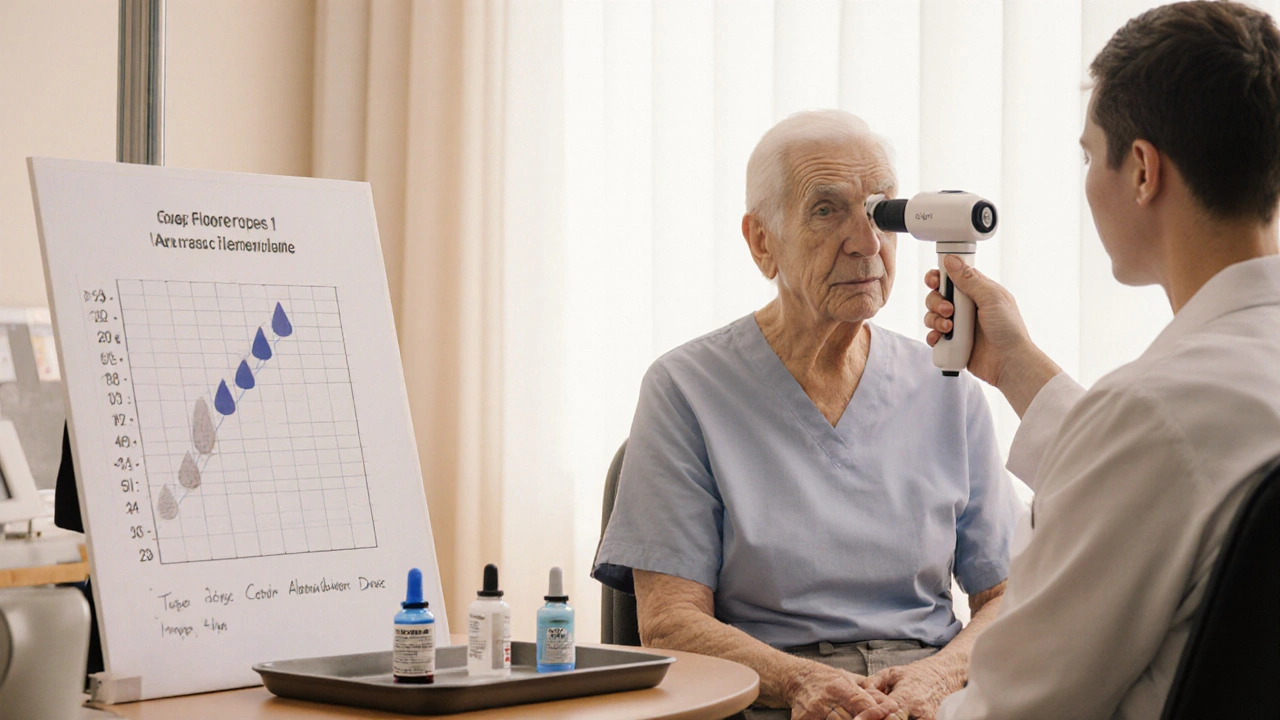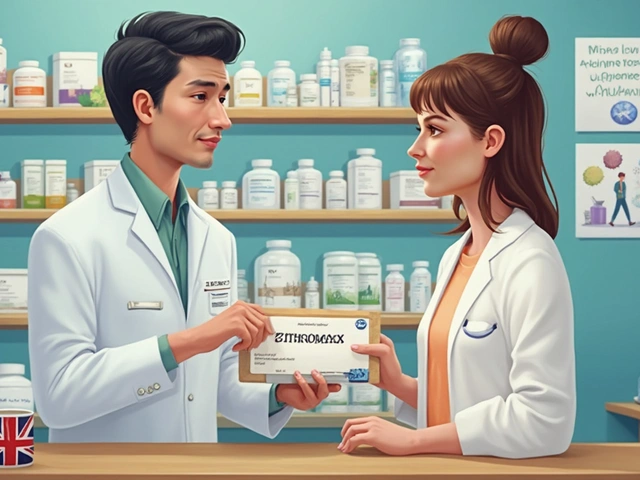Steroid Tapering Calculator for Eye Surgery
This tool helps you determine the appropriate steroid tapering schedule based on your eye surgery type. Always follow your ophthalmologist's specific instructions.
After eye surgery, a burst of redness, swelling, and discomfort is common. If not controlled, inflammation can slow healing, cloud vision, or even damage delicate structures. This is where eye steroids step in - powerful anti‑inflammatory agents that calm the immune response and keep the eye clear. Below we break down why steroids are used, which ones work best, how to apply them safely, and what to watch out for.
Why Steroids Are the First Line for Post‑operative Eye Inflammation
Steroids are a class of synthetic compounds that mimic the effect of cortisol, the body’s natural anti‑inflammatory hormone. In ophthalmology they are prized for three reasons:
- They quickly reduce vascular leakage, which eases swelling and clears corneal edema.
- They suppress white‑blood‑cell activity, preventing excess tissue damage.
- They stabilize the blood‑retinal barrier, protecting the retina after delicate procedures.
Because inflammation after procedures like cataract removal or retinal surgery can peak within the first 24‑48 hours, a fast‑acting drug is essential. Steroids deliver that speed.
Common Steroid Formulations Used in the Eye
Not all steroids are created equal. Ophthalmologists tailor the choice to the surgery type, patient risk factors, and desired potency. Below are the most frequently prescribed agents:
- Prednisolone acetate 1% - a medium‑potency drop often used after cataract surgery. Typical schedule: one drop every hour while awake for the first 24hours, then taper.
- Dexamethasone 0.1% - a high‑potency option for aggressive inflammation, such as after vitrectomy. Requires close intra‑ocular pressure (IOP) monitoring.
- Fluorometholone 0.1% - milder, suitable for patients with glaucoma risk because it raises IOP less often.
- Loteprednol etabonate 0.5% - a “soft” steroid designed to break down quickly, offering strong anti‑inflammation with a lower cataract‑formation risk.
The choice also depends on formulation: suspensions (e.g., prednisolone acetate) need shaking before use, while solutions (e.g., dexamethasone) are ready‑to‑drop.
Step‑by‑Step: Proper Use of Steroid Eye Drops
- Wash your hands thoroughly with soap and water.
- Shake the bottle if it contains a suspension.
- Tilt your head back slightly and pull down the lower eyelid to create a small pocket.
- Hold the bottle above the eye, squeeze one drop into the pocket without touching the tip to the eye or lashes.
- Close the eye gently for 1-2minutes, pressing lightly on the inner corner (nasal canthus) to block drainage into the nose.
- Repeat the process for the second eye if prescribed.
- Wait at least 5minutes before applying another medication, such as artificial tears or antibiotics.
- Store the bottle according to the label - most need refrigeration after opening.
Following these steps ensures the full dose reaches the ocular surface and reduces the chance of contamination.
Steroids vs. NSAIDs: What’s the Difference?
Non‑steroidal anti‑inflammatory drugs (NSAIDs) are also used after eye surgery, mainly to control pain and modest swelling. They work by inhibiting cyclo‑oxygenase enzymes, while steroids block a broader set of inflammatory pathways. Below is a quick side‑by‑side look.
| Attribute | Topical Steroid | Topical NSAID |
|---|---|---|
| Mechanism | Blocks multiple inflammatory mediators (cytokines, prostaglandins) | Inhibits COX‑1/COX‑2 → reduces prostaglandins |
| Onset of action | 30-60seconds | 1-2minutes |
| Potency for swelling | High - excellent for severe edema | Moderate - best for mild‑to‑moderate swelling |
| Risk of increased IOP | Yes, especially with dexamethasone | Rare |
| Risk of corneal toxicity | Low with proper dosing | Higher - especially with prolonged use |
| Typical post‑surgery regimen | Hourly for 24‑48h, then taper over 1‑2weeks | Four times daily for 1‑2weeks |
In practice, many surgeons prescribe a short steroid course plus an NSAID for pain relief, balancing effectiveness with safety.
Potential Side Effects and How to Mitigate Them
While steroids are highly effective, they carry a well‑known side‑effect profile. The most common issues include:
- Increased intra‑ocular pressure (IOP) - can lead to glaucoma if unchecked. Patients at risk (family history, steroid response) should have IOP measured after the first week.
- Cataract formation - especially posterior subcapsular cataracts with long‑term high‑potency drops.
- Delayed wound healing - rare but possible after filtering surgeries.
- Infection risk - steroids can suppress local immunity, so signs of endophthalmitis (pain, redness, decreased vision) must be reported immediately.
Mitigation strategies:
- Start with the lowest effective potency (e.g., loteprednol) for low‑risk patients.
- Schedule IOP checks at day7 and day14 for any steroid course longer than a week.
- Educate patients on warning signs - sudden vision blur, pain, or halo around lights.
- Use combination therapy (steroid + NSAID) to shorten steroid duration.
Monitoring, Tapering, and Follow‑up Protocol
Because abrupt cessation can precipitate rebound inflammation, a gradual taper is standard. A typical plan after uncomplicated cataract surgery might look like:
- Days1‑2: One drop hourly while awake.
- Days3‑5: Reduce to one drop every 2‑3hours.
- Days6‑10: One drop four times a day.
- Days11‑14: One drop twice daily, then stop if inflammation resolved.
Patients with more extensive retinal work may need a 4‑week taper, with IOP checks at weeks2 and4. If IOP spikes, the ophthalmologist may switch to a lower‑potency steroid or add an IOP‑lowering eye drop (e.g., timolol).

When Steroids Should Be Avoided or Used With Caution
Certain conditions make steroid use risky:
- Active ocular infection - steroids can worsen bacterial or fungal growth.
- Uncontrolled glaucoma - any rise in IOP can jeopardize optic nerve health.
- History of steroid‑induced IOP spikes - use the mildest agent and monitor closely.
- Pregnancy - systemic absorption is low, but ophthalmologists often prefer the safest option.
In such scenarios, an NSAID‑only regimen or a short course of a “soft” steroid like loteprednol may be the better route.
Real‑World Case Snapshot
John, a 68‑year‑old with mild ocular hypertension, underwent phacoemulsification cataract surgery. His surgeon prescribed fluorometholone 0.1% drops four times daily for a week, then tapered over two weeks. IOP was checked at day7 (18mmHg) and day14 (16mmHg), staying within safe limits. John reported clear vision by week3 and no cataract progression. This illustrates how a low‑potency steroid, paired with vigilant monitoring, can safely manage inflammation even in a pressure‑sensitive eye.
Frequently Asked Questions
How long should I use steroid eye drops after surgery?
Most uncomplicated procedures require 1‑2weeks of drops, starting with hourly dosing and tapering gradually. Your surgeon will tailor the schedule based on the surgery type and your healing response.
Can steroid eye drops raise my eye pressure?
Yes. Steroids, especially dexamethasone, can increase intra‑ocular pressure in susceptible individuals. A quick IOP check at the first week and again before stopping the drops helps catch any rise early.
Are there steroid‑free options for post‑surgery inflammation?
NSAID eye drops (e.g., ketorolac, nepafenac) can control mild inflammation and pain, but they are less effective for pronounced swelling. Often a short steroid burst combined with an NSAID provides the best balance.
What should I do if I experience blurry vision after using steroid drops?
Transient blurring can happen as the drop spreads across the cornea. If vision remains hazy after a few minutes, rinse the eye with sterile saline and contact your eye doctor. Persistent cloudiness could signal cataract formation or high IOP.
Is it safe to use over‑the‑counter steroid eye drops?
OTC steroid drops are rare and often low‑strength. Prescription drops are preferred because they are formulated for ocular use, have appropriate preservatives, and come with a dosing plan. Always follow your ophthalmologist’s recommendation.






Nidhi Jaiswal
October 13, 2025 at 13:23
Steroids act fast but never quit them abruptly